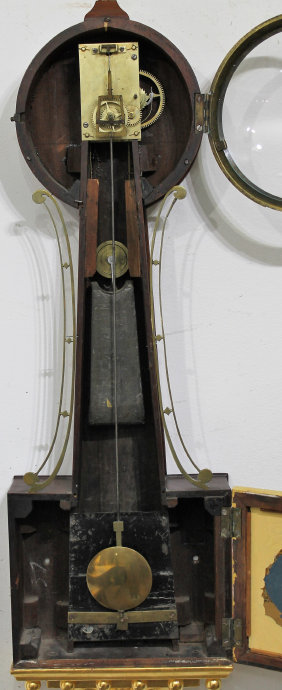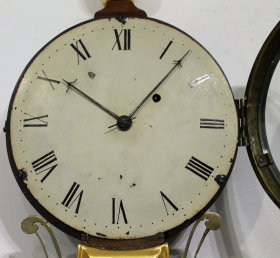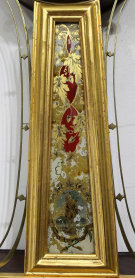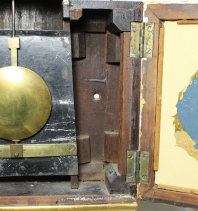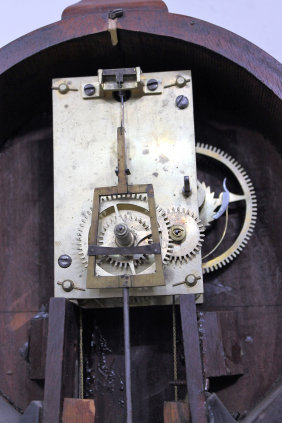
46. $1500
Willard school
Patent Time Piece, ca. 1820. I do not know who made this clock, but it bears a great many characteristics of a Simon Willard
time piece. The clock is 39 inches long, top of gilded wood finial to the bottom of the tailpiece. The case itself,
from the bottom of the finial mount to the bottom of the case (excluding the bracket/base) is 28 5/8 inches long. I believe
the top finial is an old replacement (the base of the finial does not match the OG mount). I believe the bracket (base) is a
later addition to the case; you can see this from the picture of the back. One gilded ball is missing from the left side of
the bracket. The case molding is a simple OG form, gilded; the gilding is bright but very old. The glasses and tablets
are period and touched up extensively. The throat says “Patent” at the very bottom but does not mention Willard; it is very
likely to be original, as it does not appear to have ever been out of the throat frame (see the photo of the backside of the throat
glass). The tablet closely resembles a tablet shown in Paul J. Foley’s book, Willard’s Patent Time Pieces, Fig. 459 on page
191. This is an 1815 naval battle from the War of 1812; I am not sure the tablet in this clock depicts the same battle, but
the period (1815-1820) would be the same. The wood retaining strips holding this tablet in place do not look original, suggesting
that this may be a period replacement tablet. This is important, as almost all of Simon Willard’s clocks had a geometric design
on the tablet, usually signed.
The dial glass is convex; Willard clocks occasionally had a convex glass, but I cannot exclude
the possibility that the bezel is a later replacement. The painted iron dial is also slightly convex, a characteristic of Willard
dials. However, Willard dials had distinctive minute markers, usually indicated the quarter-hours, and sometimes had a gilt
outer ring. This dial has none of those characteristics, and the numbering has been redone; I suspect the dial has been repainted,
probably long ago. It is held in place with three L-turns (suggesting a later Willard model). The hands are exquisite,
finely carved and very much like the hands Willard used.
The brass plate movement bears all the characteristics of a Simon Willard
movement: A T-bridge suspension, deep-cut teeth, two diagonal through-bolts to mount to the back of the case, and the weight
cord is secured to the lower left post. You can find many identical examples of this movement in Foley’s book, with the following
exceptions: Of greatest interest is the click-pawl, a curved piece with a finger latch. I can find no identical example
for any clock in Foley’s book, but several similar examples, including from Simon Willard. I am hoping a more knowledgeable
collector will be able to enlighten me, which I will share with you. The pendulum keystone has a cross bar, not typically found
on Willard time pieces, but one example is shown on page 32 of Foley’s book.
The 3-inch pendulum bob and duck-billed lead weight are characteristic of Willard clocks. The lower door locks with an L-turn that is operated by the winding key (included). There are many more characteristics of Simon Willard clocks listed in Foley’s book on pages 30-31; this clock meets most of those criteria. It should nonetheless be recognized that many clockmakers in the Boston area replicated Willard clocks in this time-period (1815-1825); this clock is likely to be from the “Willard school”, although it appears unlikely to have been made by Simon Willard. Regardless of who made this, it’s a damn fine banjo clock. $1500-$3500.


Antique American Clocks January 2023
